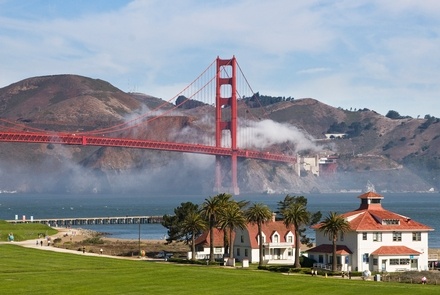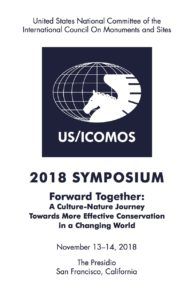
The Nature Culture Journey continues: Reflections from the US ICOMOS “Forward Together” Symposium
Brenda Barrett, Living Landscape Observer It is not news that we need a global conversation on how to integrate the conservation of cultural and natural values on the landscape. This has been an on-going discussion for decades. However, in the last couple of years the dialogue has gained momentum. At the IUCN-sponsored World Conservation Congress in Hawai’i (September 2016) a purposeful Nature/Culture Journey was launched to bring together the best ideas on the topic. This dialogue was then continued with a more explicitly cultural focus at the ICOMOS General Assembly in Delhi (December 2017).
It is not news that we need a global conversation on how to integrate the conservation of cultural and natural values on the landscape. This has been an on-going discussion for decades. However, in the last couple of years the dialogue has gained momentum. At the IUCN-sponsored World Conservation Congress in Hawai’i (September 2016) a purposeful Nature/Culture Journey was launched to bring together the best ideas on the topic. This dialogue was then continued with a more explicitly cultural focus at the ICOMOS General Assembly in Delhi (December 2017).
In November of 2018, US ICOMOS took the next step by sponsoring the symposium Forward Together: A Culture-Nature Journey Towards More Effective Conservation in a Changing World at the Presidio in San Francisco. The gathering brought together experts from six continents and 15 countries to share a range of ideas on better integrating culture and nature on the ground. The goal was development of actionable strategies for more effective and sustainable conservation.
To generate content for the gathering, a joint ICOMOS-IUCN Symposium Program Committee solicited papers from around the globe and received over 150 abstracts. These were reviewed by teams with membership in either ICOMOS, IUCN, or both. The diversity of the paper proposals was reflected in the presentations by the 45 selected speakers. Thanks to an excellent team of moderators and rapporteurs, the symposium sessions were used to both hear from the speakers and also from all participants who were challenged to identify key findings and next steps. The session presentations and the outcomes of the discussions will be available as an online publication of the papers in the new year. Preliminary cross-cutting themes and ideas have already emerged around the four conferences themes such as:
1. The overriding importance of adopting a landscape approach for the conservation of cultural and natural resources — from urban to rural places.
- There is increasing understanding that the concept of heritage is centered in a dynamic landscape. For this reason, it is critical that we adopt strategies that recognize and adapt to this reality.
- The field of conservation must adopt a landscape scale approach to address the urgent issues facing our planet, particularly our changing climate.
- Challenges remain in defining and protecting cultural landscapes – in particular those landscapes with ethnographic values.
- A better understanding of collaboration and other soft skills are critical to landscape scale management.
2. The recognition of intangible heritage and diverse perspectives is essential to integrated conservation strategies.
- It is essential to focus on both the cultural and spiritual meaning of nature.
- People are at the center of this issue and only by honoring their world view and their work up can we make a difference.
- Conservation strategies that integrate these values demonstrably improve conservation outcomes.
3. Building resilience, adaptation, and sustainability for urban and rural landscapes.
- Climate change is profoundly impacting both nature and culture and there may not be much time left.
- As demonstrated at the conference, there are many locally based initiatives to create more resilient places by blending nature and culture and employing traditional practices or adapting those practices to new conditions.
- These strategies to make the landscape more resilient need to be shared and linked for maximum effectiveness.
4. Considering the past and future of the World Heritage List from the perspective of the United States (US).
- The US was once a leader in the World Heritage program and despite changes in government policies, the interest in designation has never been higher.
- It is now understood that in the United States every World Heritage site has a cultural component.
- A strategy to engage local communities as well as the traditional users of World Heritage Sites should be a component of every location.
- Taking a landscape scale approach is a strategy to manage serial nominations.
The meeting opened with a distinguished plenary panel included Mechtild Rossler, by video from UNESCO in Paris, former US National Park Service Director Jon Jarvis, and Stephanie Meeks President of the US National Trust for Historic Preservation (NTHP). The speakers mused about their personal awakening to the importance of understanding the unity of culture and nature.
Former NPS Director John Jarvis related his experience working in Alaska and Stephanie Meeks noted her shift in perspective coming from the Nature Conservancy to the National Trust. Also, on the panel representing ICOMOS was Kristal Buckley and representing IUCN, Tim Badman both of whom reported on the commitment to working together on this critical issue.
In listening to the presentations and the subsequent discussion, symposium attendees were struck by the work that is going on “out there” and how it has been localized and adapted to meet community needs. The usefulness of merging the two perspectives is bubbling up from practice in the real world. However, there is a need to develop more informed policies in regions of the globe and strengthen the understanding of local governments. It was noted that the fields of culture and nature are divided from the top, but not from the bottom. Taking an integrated landscape approach seems to be delivering better conservation outcomes, but there are many opportunities to make the work more effective.
With only 160 attendees at the symposium, it is fair to ask who was not in the room? There is a need to include more representation from nature conservationists, and also a stronger commitment to social justice and equity. Another sector that might make a meaningful contribution is the arts and humanities. Overall conference goers were impressed by the enthusiasm and vitality of the conservations. All agreed that the strong presence of young practitioners and students gave the event a lot of energy and a feeling that what we are doing is very important for our shared future. Everyone looks forward to the next steps, which include a declaration of the symposium’s top-level findings and publication of the papers presented at the event.
A version of this essay was first published by the Living Landscape Observer in December 2018; it is reused with permission here.

